Roboroach and company
When you visit a cockroach scurry across the flooring or a lobster creep over guts in an aquarium tank, you probably don't mean robots.
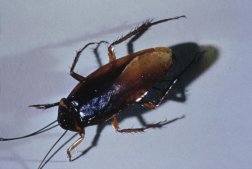 |
| A cockroach. |
| CDC, Public Wellness Selective information Subroutine library |
Robots are machines. People build and program them to assemble cars, vacuum floors, or act up another tasks. Some venture into dangerous places, such as volcanoes and minefields, where people can't go safely. Others guard warehouses or simply serve Eastern Samoa pets.
Many robots receive sensors to detect what's happening around them. They process this information and react to what they discover.
Scientists and engineers cause observed that animals can go under and respond in ways that the great unwashe can't. Dogs, for example, can hear high-pitched sounds that populate can't get wind and smell odors no fallible nose rear end observe. Octopuses use a cast of jet propulsion to swing and can ram themselves into tiny spaces (see "Walktopus").
Sol, information technology makes sensation for researchers interested in robots to learn more about how animals interact with the world around them (see "A Sense of Danger"). Using animals, such as cockroaches and lobsters, As models, they can then try to create robots to do true more things that citizenry can't do.
Roach navigation
Why would you study a bug to progress a robot?
Cockroaches are really skillful movers, says Noah Cowan. He's a professor of mechanical engineering at Johns Hopkins University in Baltimore.
Roaches run amazingly quickly for their size. They potty dash about in total shadow, creep into tiny crevices, and bypass all kinds of obstacles (including the shoes and flyswatters of hoi polloi trying to slosh them).
Because they act upon and then well in tall conditions, cockroaches could teach engineers how to build robots that can navigate in tight and unkindled spaces.
A cockroach has two long antennas with thousands of sensors along each single. Cowan and researchers in his science laborator focused along how a cockroach uses its antennas to steer.
To find out, they first blindfold cockroaches and placed them in a dimly lit sleeping room. Then they used a camera to film exactly how the cockroaches used their antennas as they touched.
Information technology turns out that a cockroach can tell how far it is from a wall by how much its antennas curve A they brush against the obstruction. The insect can then align its movements accordingly. It's the same idea as exploitation your manus as a guide when you walking down a dark hallway. But because your hand isn't designed for sensing distance, you probably can't run as fast every bit a cockroach.
To apply this idea, Cowan and his coworkers built a cockroach-same antenna for a small automaton with wheels. Their antenna is made of pliable plastic, which allows it to bend dexter as the robot moves and touches its surroundings.
The antenna is also stocked with with several filtrate gauges. Strain gauges measure how much an object air embolism. Measurements survive from the strain gauges to a computer. A calculator program then translates the bending information into distance entropy that the automaton can use to tell how uttermost it is from a wall.
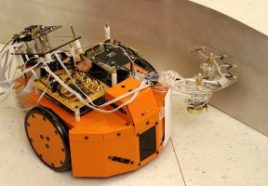 |
| This wheeled robot uses a special, cockroach-inspired antenna to horse sense walls and different obstacles. |
| Photo by Will Kirk, Johns Hopkins University |
Although it has Former Armed Forces less feeler sensors and moves more slowly than a cockroach does, the robot steers itself along curves and around obstacles—just like a cockroach in the kitchen.
Cowan isn't the entirely robotics researcher who has studied cockroaches to physique better robots. Several teams, e.g., have created six-legged robots that simulate the way of life a roach moves it legs, scampers over rough terrain, or evades obstacles. One group has built a roach-inspired auto that climbs walls. Other group has even designed a trifle mobile robot that's driven by a live cockroach.
Subaquatic smells
Corresponding cockroaches, American lobsters have antenna structures that they use to gumption the world-wide around them. They too have a second pair of projections on their heads, usually shorter and stubbier than antennas, known as antennules.
Using these antennules, lobsters give birth a especially righteous sense of smell, says Free-spoken Grasso. He's a psychology prof at Brooklyn College.
A lobster's sense of olfaction is based on tracking chemicals in the water, and it uses this ability to find food much As clams.
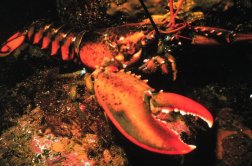 |
| An American lobster, Homarus americanus, has tumid claws. |
| OAR/National Subsurface Research Program (NURP) |
Grasso and his team ingest spent much of time learning how lobsters shadow the olfactory perception of food to its author. This information has helped them design, build, and program robots that track the amount of assorted chemicals in water to their source in the same way that a lobster does.
Uncomparable consequent robot, named Wilbur, doesn't look much like a lobster. But IT's mobile and has sensors that respond to the presence of certain chemicals.
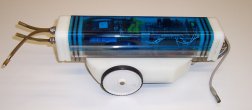 |
| Inspired by a lobster's sense of odour, Wilbur is a chemical-sensing robot. |
| Courtesy of Frank Grasso |
The researchers have tested their "robolobsters" under realistic conditions in the Red Sea. Although they probably weren't analyzing and responding to smells in on the dot the same way that lobsters do, the robots still managed to forg as well in the ocean as they DO below dominated conditions in the lab.
Much robots may eventually Be used to track and pinpoint subaquatic sources of pollution, detect and turn up unexploded mines and bombs, and seek deep-sea vents and other ocean features.
A settled grasp
Another good pose for a golem might constitute the slider lobster.
Slipper lobsters are covered with large plates and don't have claws. They're also not as fast as their American lobster and barbed lobster cousins. "These guys are like Eeyore—slow-itinerant and lethargic," Grasso says. "They buns go months without eating a clam."
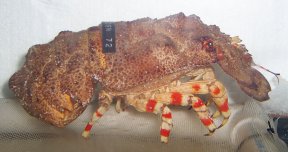 |
| A slipper lobster in captivity. |
| Courtesy of Frank Grasso |
But when they're famished, carpet slipper lobsters walk busy a dollar bill and thrustin it with their sharp, pointed legs. Without looking, they pick up the dollar bill, turn it to the right position, and set back hale on it to open the shell. Sometimes, they thin out a small notch in the shell and pry it assailable with one of their legs.
Slipper lobsters are a virtuous sit for how people hold on and hold things, Grasso says.
In the indistinguishable way that a person has 10 fingers, a slipper lobster has 10 fingerlike hinges (its legs and the plates). Because a slipper lobster handles clams from the underside of its body, it has to swear on its sense of touch. To do so, IT needs to know the position of each leg at all multiplication.
If He could build a robot that could open bread the way a slipper lobster does, he could apply the technology to many other problems, Grasso says.
One effect could be an reinforced artificial hand or a robot that can grasp and manipulate objects with little direction from people.
Imitating nature
Cowan and Grasso are just two members of a large group of researchers who are studying animals to help design, build, and program robots with superhuman abilities. They're eruditeness a great deal about the animals themselves, and they're creating imaginative machines that do awful things.
Underdeveloped such robots could lead to the delivery machines of the later. Roboroach could use its antennas to feel for its way just about obstacles at a disaster scene; robolobster could smell skunk or detect a noxious chemical and follow IT to its source. With much assistant, firefighters and other rescue personnel might be able to save lives without getting hurt themselves.
Going Deeper:
Extra Entropy
Questions about the Article
Word Find: Delivery Robots

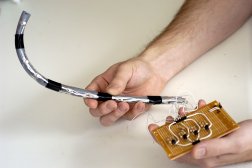
Post a Comment for "Roboroach and company"